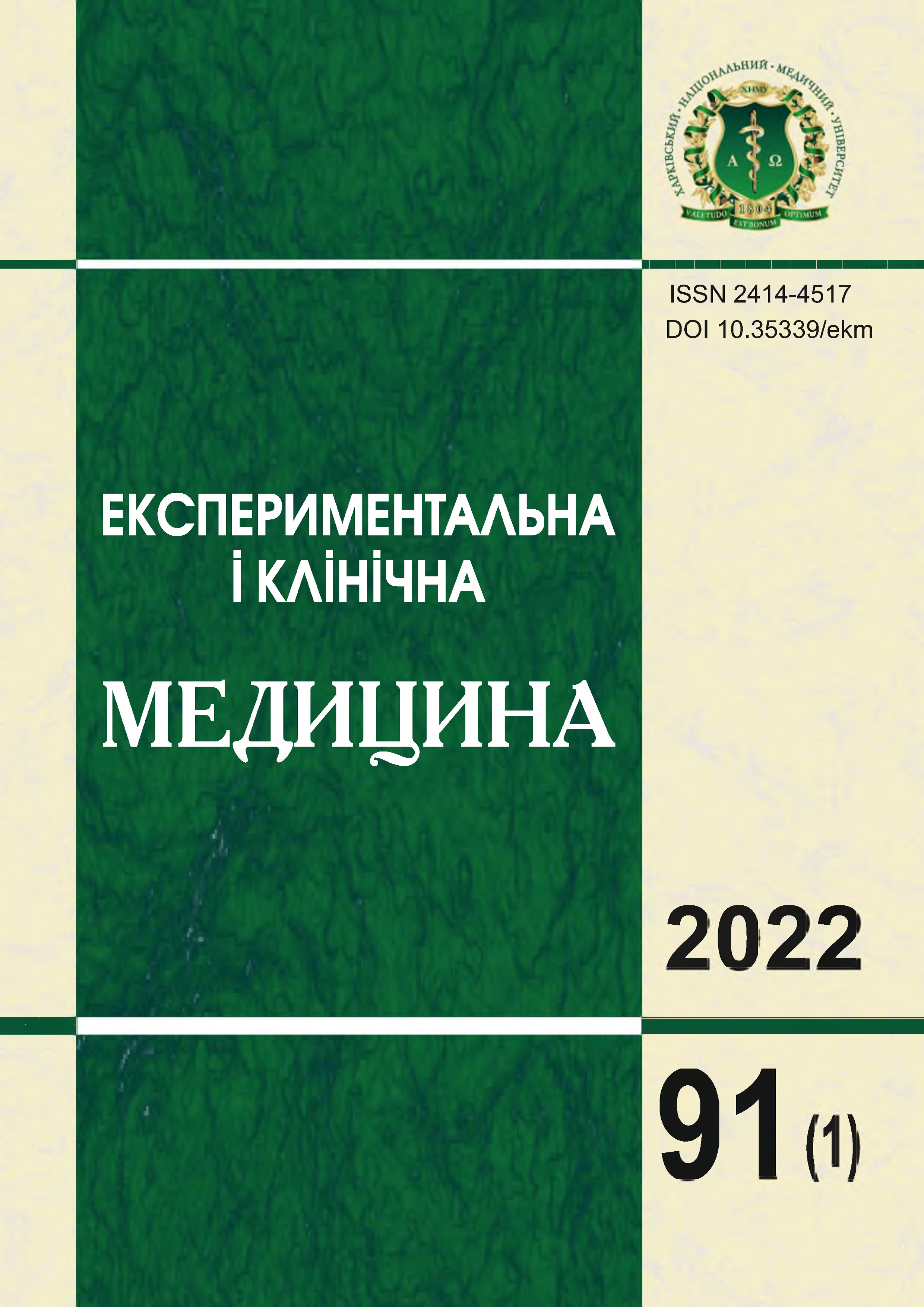Abstract
The impact effect assessment of ethylmethylhydroxypyridine succinate on the energy efficiency of blood circulation in patients with polytrauma without traumatic myocardial injury during chronic heart failure. The state of blood circulation was studied in 66 patients with polytrauma without myocardial injury on the background of CHF. Troponin I levels in all patients did not exceed 0.3 ng/ml, and NT-proBNP – was above 100 pg/ml, which confirmed the presence of chronic heart failure. Patients has been divided into 2 groups. Group S (n=33) – patients receiving standard intensive care, group E (n=33) – patients who were additionally injected with ethylmethylhydroxypyridine succinate 600 mg/day during a week. NT-proBNP, hemodynamics, oxygen and energy budget within the admission, on the 3rd and 7th day were investigated. The indicators of the energy budget, estimated by the circulatory reserve (CR), has been improved in all patients. Upon admission and on the 3rd day, it was not differ between groups, on the 7th day the CR in groups C and E was accordingly 286±94 and 392±173 mW/m2 (p<0.003). The level of NT-proBNP on the 7th day in groups C and E decreased to (109.1±8.5) and (65.8±23.3) pg/ml (p<0.001). Chronic heart failure aggravates the course of acute hypovolemia in patients with polytrauma without myocardial damage. The main cause of aggravation of circulatory failure during polytrauma without traumatic myocardial damage is energy deficiency in the myocardium. Ethylmethylhydroxypyridine succinate reduces the myocardial energy requirement. The effect of ethylmethylhydroxypyridine succinate begins to develop after 3 days, reaching a maximum on the 7th day.
Keywords: polytrauma, heart failure, NT-proBNP, ethylmethylhydroxypyridine succinate, energy of blood circulation.
References
Loskutov OA. Druzhina AN. Kolesnikov VG. Loskutov DO. Taktika intensivnoy terapii pri massivnykh travmaticheskikh krovotecheniyakh. Meditsina neotlozhnykh sostoyaniy. 2016;4(75):196-7.
Advanced trauma life support (ATLS®): the ninth edition. ATLS Subcommittee; American College of Surgeons' Committee on Trauma; International ATLS working group. J. Trauma Acute Care Surg, 2013;74(5):1363-66.
Kobelyatskiy YuYu. Yovenko IA. Tsarev AV. Kuzmova EA. Perederiy MN. Intensivnaya terapiya politravmy s pozitsiy sovremennykh mezhdunarodnykh rekomendatsiy [Intensive care of polytrauma in terms of current international guidelines]. Meditsina neotlozhnykh sostoyaniy [Emergency medicine]. 2017;7(54):9-14.
Tsili staloho rozvytku: Ukraina. Natsionalna dopovid. [Sustainable Development Goals: Ukraine. National report]. Kyiv: Ministerstvo ekonomichnoho rozvytku i torhivli Ukrainy. [Kyiv: Ministry of Economic Development and Trade of Ukraine], 2017. 176 p. Available from: https://www.ua.undp.org/content/ukraine/uk/home/library/sustainable-development-report/sustainable-development-goals--2017-basseline-national-report.html
Mykhnevych KG, Volkova YuV, Khartanovych MV, Lyzohub MV. Enerhetychni aspekty krovoobihu. Monohrafiia [Energy aspects of blood circulation. Monograph]. Kharkiv: SPD FO Stepanov VV, "Planeta-Prynt". 2020. 165 p.
Kireev I, Orobets V, Sevostyanova O, Shakhova V, Agarkov A. Prospects of using antioxidant drugs for the treatment and prevention diseases of farm animals. Research Journal of Pharmaceutical, Biological and Chemical Sciences. 2018;9(5):2031-6. Available from: https://www.rjpbcs.com/pdf/2018_9(5)/[254].pdf
Magata F, Morino I, Teramura M, Tsunoda Ei, Kawashima C, Haneda S, et al. Impact of metritis on the generation of reactive oxygen species by circulating phagocytes and plasma lipopolysaccharide concentration in peripartum dairy cows. Animal Science Journal. 2017;88(2):248-53. DOI: 10.1111/asj.12642.
Mahad DH, Trapp BD, Lassmann H. Pathological mechanisms in progressive multiple sclerosis. Lancet Neurol. 2015;14:183-93. DOI: 10.1016/S1474-4422(14)70256-X.
Trentz O. Polytrauma: pathophysiology, priorities, and management. In: Ru¨edi TP, Murphy WM, editors. AO principles of fracture management. Stuttgarg, New York: Thieme-Verlag; 2000. p. 661-73.
Vitetta L, Linnane A. Endocellular regulation by free radicals and hydrogen peroxide: key determinants of the inflammatory response. Inflammopharmacology, 2014;22(2):69-72. DOI: 10.1007/s10787-014-0199-7.
Henry JP, Gauer OH, Reeves JL. Evidence of the atrial location of receptors influencing urine flow. Circ Res. 1956;4:85-90.
Flynn TG, De Bold ML, De Bold AJ. The amino acid sequence of an atrial peptide with potent diuretic and natriuretic properties. Biochem. Biophys. Res. Commun. 1983;117:859-65.
Suga S, Nakao A, Hosoda K, et al. Receptor selectivity of natriuretic peptide family, atrial natriuretic peptide, brain natriuretic peptide, and C-type natriuretic peptide. Endocrinology, 1992;130:229-39.
Vanderheyden M, Bartunek J, Goethals M. Brain and other natriuretic peptides: molecular aspects. Eur. J. Heart Failure, 2004;6:261-8. DOI: 10.1016/j.ejheart.2004.01.004.
Bettencourt P. NT-proBNP and BNP: biomarkers for heart failure management. Eur. J. Heart Failure, 2004;6:359-65. DOI: 10.1016/j.ejheart.2004.01.008. PMID: 14987589.
Parwani S, Parwani R. Nitric oxide and inflammatory periodontal disease. General dentistry. 2015;63(2):34-40. PMID: 25734284.
Bala A, Mondal C, Haldar P, Khandelwal B. Oxidative stress in inflammatory cells of patient with rheumatoid arthritis: clinical efficacy of dietary antioxidants. Inflammopharmacology. 2017;25(6):595-607. DOI:10.1007/s10787-017-0397-1.
Zozuliak NV. Potentsiiuvannia antyishemichnoi terapii khvorykh na stabilnu stenokardiiu III FK [Potentiation of anti-ischemic therapy in patients with stable angina III FC]. Halytskyi likarskyi visnyk [Galician Medical Bulletin]. 2017;24(1):14-6.
Babushkina A.V. Problema tolerantnosti k nitratam. Molsidomin [The problem of tolerance to nitrates. Molsidomin]. Ukr. med. Chasopys [Ukrainian Medical Journal], 2011;2(82):45-8.
Sviridova NK. Ishemicheskiy insult i infarkt miokarda: perspektivnyye terapevticheskiye tseli dlya zashchity mozga i serdtsa [Ischemic stroke and myocardial infarction: promising therapeutic goals to protect the brain and heart]. East European journal of neurology. 2018;3(21):26-32.
Bender A, Beavo J. Cyclic nucleotide phosphodiesterases: molecular regulation to clinical use. Pharmacol Rev. 2006;58(3):488-520.
Mikhnevich KG. Volkova YuV. Baranova NV. Boyko EV. Opredeleniye referentnykh znacheniy energeticheskikh pokazateley krovoobrashcheniya [Determination of reference values of energy indicators of blood circulation]. Ukrainskyi zhurnal medytsyny, biolohii ta sportu [Ukrainian Journal of Medicine, Biology and Sports]. 2020;5:4(26):182-8. DOI: 10.26693/jmbs05.04.182.

